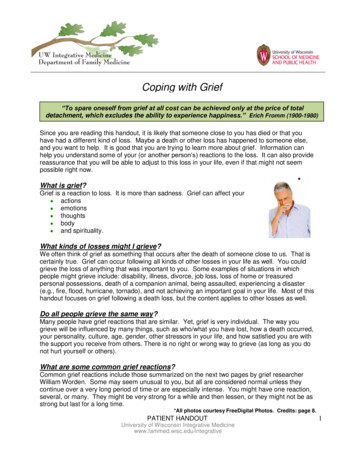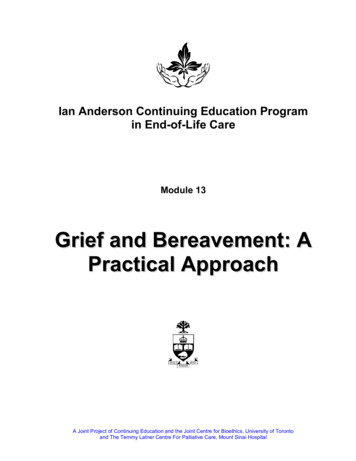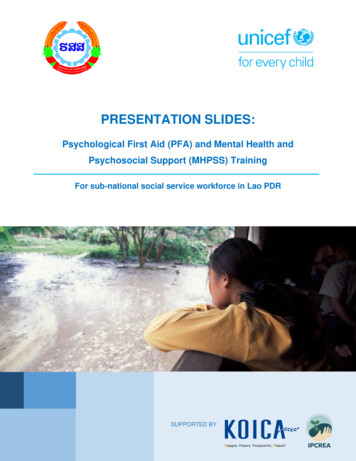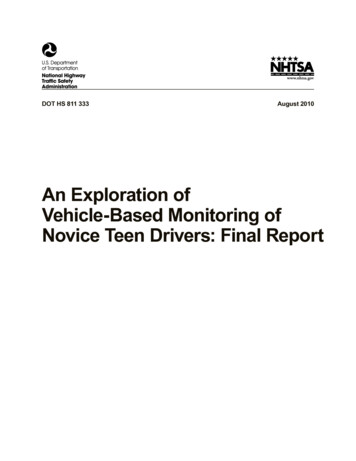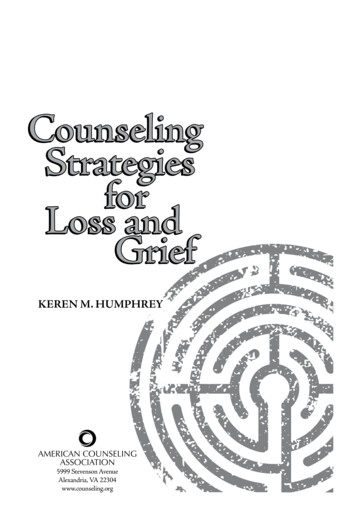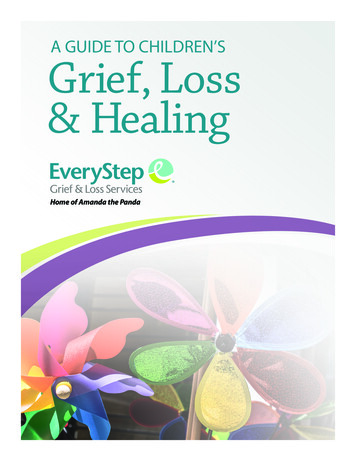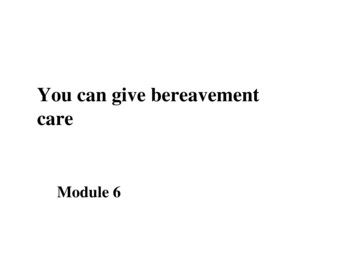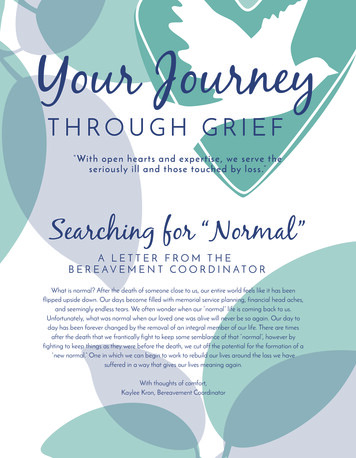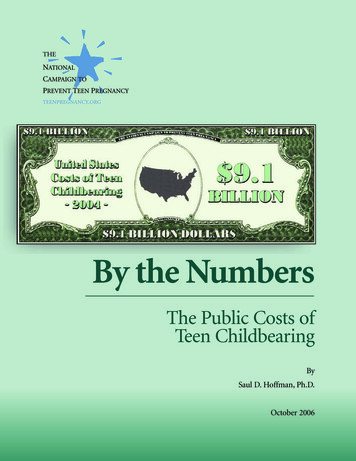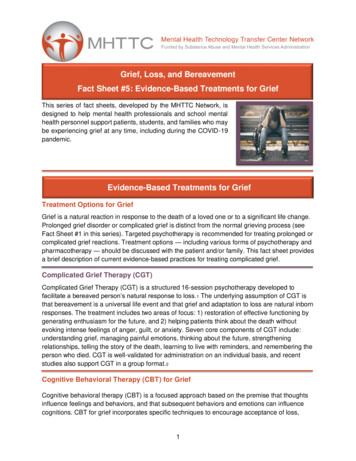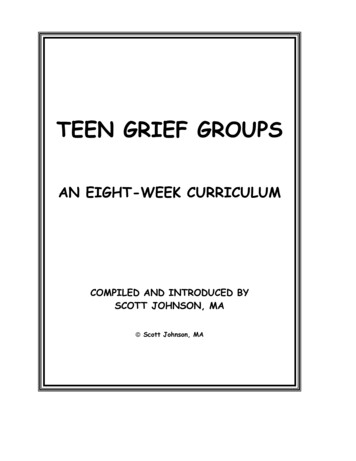
Transcription
TEEN GRIEF GROUPSAN EIGHT-WEEK CURRICULUMCOMPILED AND INTRODUCED BYSCOTT JOHNSON, MA Scott Johnson, MA
ACKNOWLEDGEMENTSI would like to thank all who made this possible – The many authors of the activitiesThe Hospice of Grossmont Hospital (Jill Fitzgerald and Kathi Olsenand, in particular, Kay Cogswell, my supervisor, who gave mepermission and support to develop the Child and AdolescentBereavement Program)The Jenna Druck Foundation, Ken Druck, Julie Allen, DeniseHankins and Joelle James who supported me in this projectThe Hope Bereavement Center of the Hospice of the North Coastfor their generous support in the continuation of the work withgrieving studentsThe schools and counselors who allowed me to learn while I helpedthem with their groupsMost importantly, I want to thank the grievers- children, adolescentsand adults- who taught me what I know about grief.Lastly, a special acknowledgement should go to the Jenna DruckFoundation for the copying and distribution of the initial edition ofthis manual.
2000 -2010 Scott Johnson, MA. All Rights Reserved.Any part of this manual may be copied and distributed with two caveats:1. No part of it is sold.2. Original sources/creators of the activities or handouts are acknowledged.For more information, contact me at:scottnsd@gmail.comhttp://griefed.wordpress.com/
TABLE OF CONTENTSINTRODUCTIONNEED AND EXPECTATIONS FOR A TEEN GRIEF GROUPROLE OF GROUP FACILITATORSETTING UP THE GROUPSCREENING STUDENTSGROUP STRUCTURE/AGENDAEIGHT-WEEK CURRICULUMSECTION I: TEEN ACTIVITIESSECTION 2: HANDOUTS FOR TEENSSECTION 3: HANDOUTS FOR COUNSELORS AND PARENTS
INTRODUCTIONThis curriculum is presented as a work manual for the counselor facilitating adolescent griefgroups in a school setting. It is a compilation of activities and handouts that are meant to beused, copied, added to or discarded according to the preferences of the user.Most simply it is a sample eight-week teen grief group with suggestions for organization of eachgroup meeting. There are introductory sections on setting up and running a group followed bythe eight-week curriculum completed by the appendices of activities and handouts.NEED AND EXPECTATIONS FOR A TEEN GRIEF GROUPThe need for a teen grief group is not always apparent. It is my experience that for about everythousand students at a school 50 of them are actively grieving a loss by death. About one halfof those students will be known to school personnel once a group has been up and running forabout a semester. About ten to fifteen of those students will attend a robust group. Therefore,although a group will be helpful to some students, it will not be the answer to all.In addition, some students will be benefited in a dramatic way by such a group the benefit toothers may not be so apparent. Their classroom conduct and performance may not improve forseveral semesters. These students, after all, have gone through major life events at a crucialtime in their development. Anyone who is grieving intensely is focusing their learning onunderstanding questions like “how the world can be put together to allow for whatever hashappened” and “what are these feelings that have torn this world apart?”ROLE OF GROUP FACILITATORI understand the role of facilitator to be the provider of a safe place for the grief work to occur. Itis based on the premise that each person has an innate understanding of the work he or sheneeds to do. Students will become expert on their grief. When they feel safe, the work thatneeds to be done is done. All the group rules – which I like to let the group generate – arerooted in the idea of safety: confidentiality, not interrupting, listening, etc.You, as facilitator, start and end the group. You also help the group to regulate discussion –keeping strong members from dominating and bringing out quieter ones – with their permission.I urge you to give members permission to not share before they are ready. These structuralcomponents are an important part of the members feeling safe.SETTING UP THE GROUPThis manual grew out of a suggestion that it might be more comfortable for counselors venturinginto doing a teen grief group to have it be a structured, didactic, closed group of a set number ofweeks. The length of eight weeks was somewhat arbitrary. We found at Grossmont Hospicethat ten weeks was ideal. We did not have to deal with school schedules. The more successfulgroups have the support of teachers and administrative personnel. One of the ways they retainthis support is to work around their school exam schedules. This leaves them with fewer weeksto do their groups in. For example at Granite Hill High School in El Cajon, the groups are sevenweeks.Factors to consider before starting a group: The number of weeks for the group including start and end dates. It is important to allow fortime before the start of group to screen students and build relationships with them. Weekly rotation schedule.
Co-facilitator.Schedule meeting each week with co-facilitator or another counselor to debrief and planLocation of group: privacy, same room for all groups, table for activities.Materials available. Consider having a folder for each student to keep any activities in. Atthe last group these ‘memory books’ would be returned to the students.Recruiting faculty support to find appropriate students and in letting them out of class.Create a way to get students to group quickly. Some schools have a system where studentsand teachers are notified the previous day and student reports directly to group.Become familiar with the clinical themes students are likely to bring to group and individualmeetings. Expect that students will begin to drop by your office during the week and longafter the groups are completed.SCREENING STUDENTSAlthough the screening of each potential attendee ensures that students inappropriate for groupmembership are kept out, it serves at least two other important purposes:1. It educates about the group rules and purposes.2. Building the relationship with each student upon which the strength of the group is built.Some group criteria to consider: Do not mix students with primarily pre-death or divorce issues with students who aresurvivors of loss by death. Either the non-‘death’ students will feel threatened and will notattend or will distract or the ‘death’ students will not share. The death should be at least two to three months before group start. The student will oftenbe too numb to get much from group and his or her defenses may be overwhelmed by thegroup experience. Instead, offer individual support until another group is available.Consider introducing a student to another whose grief is more mature. Group needs take precedence over the individual’s.Other considerations: Screenings can be awkward. Have a focal point for discussions. Ask them to fill out the ‘Teen Grief questionnaire’ or similar instrument. You will get thebasic information you need, screen for suicidal ideation, structure your interview, and makesure you have covered the bases. It will also begin to help the student normalize her or hisgrief experience. Have a ‘distracter’ such as modeling clay or Sculpee available for them to work with duringthe meeting. This may lessen anxiety and free up conversation. Sculpee works well duringtalking portions of the group as well.GROUP STRUCTURE/AGENDACaveat: An agenda with activities is helpful but the best groups are often those where,when we are following what is hot for the group, we forget about the agenda.Each group in this curriculum will have the following components:1. A theme with tools to be learned.2. An opening ritual. This may be only your way of starting the group, which becomes expectedand therefore ritual.3. One or more activities.4. Handouts.5. Closing ritual.Based on the experience of clinical themes in other groups the major themes will be coveredover the eight weeks. Expect that students will introduce themes on a given week that will
either be related to the major theme of that week or may supersede that week’s theme inimportance. It is a judgment call on the part of the facilitators whether to stay with a giventheme.The major themes are:1. Introduction and Ice-breaking2. Memory building3. Family changes4. Feelings of grief5. Coping tools6. Good-byes and memorialsThere are also activities that are a part of nearly every group. These may include the memorymural, question basket, in-depth sharing of momentos and stories of the loved one.OpeningsEveryone has their own style for opening a group. It is important to have a phrase like; “Lookslike most of us are here, let’s start now.” This makes a transition from whatever chatter or crosstalk is going on to a focus on the purpose of he group. Other matters to include in the openingare the reinforcement of group norms/rules, introduction of theme and activities, reminder thateach student can have ten minutes or so to share about the loved one (encouraging them tobring music and momentos). Ask if anyone has brought something to share today. Follow upon any assignments or suggestions students took home from end of previous group.ClosingsIt is important to prepare for the end of each group. While most high school students will bethinking about the next class and start modulating their interior life accordingly, youngerstudents are not so good at this.I spend about the last 10 minutes of a group first checking in with students who have beenquiet, giving them a place to share if they wish. After that, I try to help the students change to adifferent part of the brain to help ground them. Very often, this is accomplished by going overone of the handouts or engaging them in a discussion of tools that have helped them in thepast. Everyone shares one or two. A list is kept. Then each person chooses one to commit totrying this coming week (be sure to write down and follow-up the next week).Another way to disengage is to ask them how this group was for them. This gets them toreflect back and therefore distance themselves from what has been happening.It is important to end promptly (another example of that structure thing that adds to sense ofsafety). Most schools have provisions for students to go to nurses' office and lie down for ashort while if necessary. Occasionally a student may want to debrief for a short while. It is notuncommon to write some late passes from time to time.
EIGHT – WEEK CURRICULUMWeek One: Theme(s): Ice-breaking, introductions, group norm building.Opening: brief intros, develop rules, invitation to share.Activity1: ‘Move”; Talking stick.Activity2: “What got me here”; Question basket.Handout: ‘Normal Grieving’, ‘Physical Effects’.Closing: re-invite sharing, review handout, ask about what helps (see introduction).Week Two: Theme(s): Getting to know each other, memory building.Opening: Review ‘what helps’ from last week, Invitation to share, ‘memory mural'.Activity: Choose from ‘My Story’, ‘What do You Need?’ &/or Question Basket.Handout: ‘Bill of Rights for Teens Experiencing Grief’, ‘Common Myths About Grief’.Closing: Review handouts, remind to bring sharing, ‘ what are you going to do to take careof you?’Week Three: Theme: Family and other changes since the death.Opening: Review ‘what you did to help’, Memory Mural, and Invitation to share.Activity: Choose from ‘What do you need’ (if not done last week)? ‘Timeline’, Writing lettersto Parents, ‘What has changed in your life’, ‘Rough Mountain Smooth Mountain’.Handout: ‘Conquering Depression’.Closing: As above.Week Four: Theme: Follow-up on Family changes, ‘Feelings’.Opening: Review ‘homework’, memory mural.Activity: Choose from ‘Four Feelings’, ‘Anger Circle’, ‘I miss you most ’&/or Collage.Handout: ‘Words of Feelings’.Closing: As above.Week Five: Theme: This is a transitional group: either continue with last week (Feelings) or begin‘Coping’.Opening: As above.Activity: Continue with feeling activities &/or ‘Faces’, ‘Garbage in Garbage out ’, ‘LightHearted Personality Profile’, ‘Unpack grief Bundle’.Handout: ‘How to help grieving people’.Closing: as above, remind how many meetings left.
Week Six: Theme: Tools.Opening: As above; remind number of week’s left.Activity: Choose from ‘Question Basket’, ‘Shield’, ‘Dear Aunt Blabby’, &/or ‘Future Fears’.Handout: ‘Strategies for Coping’, ‘Good-bye Letter’ (from Activity List).Closing: as above.Week Seven: Theme: Good-byes.Opening: As above.Activity: ‘Forgiveness Circle’, ‘Memorial Activity’.Handout: ‘Establishing realistic expectations for your grief’.Closing: Discuss favorite snack (if doing this).Week Eight: Theme: Good-byes.Opening: As above, review.Activity: ‘Memorial Activity’, Favorite snack, Momentos to share.Handout: Memory books.Closing: Rose Petals.
SECTION I: TEEN 1.371.381.391.401.411.42CHAIN OF EVENTSCLAY ACTIVITYCOLLAGECOLOR YOUR HEARTDEAR AUNT BLABBYFACESFEELINGS AND COLORSFORGIVENESS CIRCLEFOUR FEELINGSFUTURE FEARSGARBAGE IN . . . GARBAGE OUT . . .HOW DO YOU FEEL TODAY?I MISS YOU MOST WHEN . . .JOURNALS FOR THE WEEKKLEENEX TOSSLETTER TO THE DECEASEDLIGHT-HEARTED PERSONALITY PROFILEMEMORIAL ACTIVITYMEMORIAL QUILTMEMORIESMEMORIES IIMEMORY MURALMOVEMY STORYNOW AND THENQUESTION BASKETQUESTION BASKET – SAMPLESROSE PETALS: CLOSING RITUALROUGH MOUNTAIN, SMOOTH MOUNTAINSHIELDTIMELINETHE TIMES OF MY LIFETALKING STICKTHANKFUL ALPHABET THOUGHTSTOMBSTONE ACTIVITYTHE UNGAMEUNPACK YOUR GRIEF BUNDLEVICTIMS DON’T HEAL!WHAT DO YOU NEED?WHAT GOT ME HERE?WHAT HAS CHANGED IN YOUR LIFE?WHERE ARE YOU?WRITING LETTERS TO PARENTS
CHAIN OF EVENTSAge Level:AllTime Required:FlexibleMaterials Needed:Scissors, tape, staples or glue sticksConstruction paper cut into 8 x 1” stripsCrayons or markersGoal:1. To reconstruct a series of events around a certain aspect of the death. For example,the events leading up to the disclosure of an illness, or the events of the funeral andits preparation.2. As a variation, to link group participants names with their names of deceased lovedones and each other. Our heart connection is made symbolically visible.Description of Activity:1. Each child cuts number of strips of construction paper.2. On each strip they write an event and/or its corresponding feeling. For example, thefirst strip might say: Daddy never feels well anymore. The second strip might be:Mom took daddy to the doctor, everyone is telling secrets, etc.3. Strips are then glued, taped or stapled into rings to form a “chain of events”.4. Discussion should then center on feelings that happened during that time frame.Teen Talk, Good Samaritan Hospice – Taken from Bereavement Magazine, Nov/Dec, 19941-1
CLAY ACTIVITYAge Level:AllTime Required:45 minutesMaterials Needed: Soft clay Plastic table cloths Small objects to put into clay (i.e., pencils, buttons,straws, etc.)Description of Activity:Frequently, our actions speak louder than our words. Grief is difficult to express attimes, especially when dealing with anger and frustration.Tell the group they don’t have to “make” anything 0 we are just experimenting with thefeel and shapes of the clay. Ask them to think of thoughts such as anger, frustration orsadness. Give the group time to get into their feelings quietly. As they think, encouragethem to work with the clay – squeezing, shaping or pounding.Have each person share his/her thoughts. As they share, be aware of their bodylanguage, especially their hands. See if their body language matches their words. Ifthe two are different, share your observations and explore them with the individual.Example: Participant is pounding pencil into clay as he or she says they areexperiencing no frustration or anger.Some people make letters out of their clay. As an example, one girl spelled the word“AIDS” and then smashed it with the remainder of her clay. Others may make an objectlike a bottle and then destroy it, symbolizing their hatred of alcohol. Some may simplyplay with a ball of clay as they speak and feel no desire to create anything. Have themtell you how the clay feels – texture, temperature, etc. This helps the individual to reallypay attention to what he/she is doing so that they are fully present in the moment.This exercise is not meant to be analyzed in depth. It is simply an experiment inexploring new ways to get in touch with feelings. It is a very popular activity.TAG / Teen Age Grief, Inc., Copyright 19901-2
COLLAGEAge Level:AllTime Required:45 minutes – FlexibleMaterials Needed:MarkersGlueMagazinesScissorsConstruction paper (good size is 11” x 17”)Goal:To share feelingsDescription of Activity: Provide plenty of magazines and have each participant cut out pictures thatrepresent memories of the deceased. Ask each member to share their collage and the feelings that are brought to thesurface as a result.1-3
COLOR YOUR HEARTAge Level:10 - TeenTime Required:45 – 60 minutesMaterials Needed:marking pensConcentric heart picture, color code sheet, crayons or(black, green, red, purple and gold)Goals:1. Explore feelings.2. Explore / recognize changes in feelings brought by healing.3. Embrace contradictory feelings.4. Understand sameness / differentness with other’s feelings.Description of Activity:1. Concentric heart picture is distributed as a “picture of our grieving heart”.suggested meanings for each color are also passed out.The2. Group members are invited to read the suggested meanings for colors and thencolor their own heart in a way that is meaningful to them.3. They will be invited to share their hearts after 15 minutes (or whatever) of working onthem. Coloring may continue during sharing.4. The hearts may be dated and blank pages distributed for future use as a healingassessment.1-4a
BLACKUsually lasts from a few days to a fewmonths after I learn of the death. Attimes, I may experience a lack offeeling or numbness; other ,depression,abandonmentordisbelief.Sometimes I can’t cry;other times I can’t stop crying. Thedeath is so painful and shocking toconsider that I may put it out of mymind as much as possible. I maywant to have fun all the time, or elsewithdraw from my friends andbecome a loaner.GREENThe reality of the death begins to sinkin. I can name what it is that upsetsor bothers me so much about thedeath. I want to talk about whathappened. I feel an urge to askquestions about it. I can share someof my thoughts and feelings withthose whom I trust. I can admit that Ifeel (finish the sentence) . . . . .REDThoughts and feelings I could notlook at before begin to surface. (Ididn’t even know some of these werethere!)Again, I sometimes cryuncontrollably.I wonder if I amgetting worse instead of better. I maylose my temper over practicallynothing. It may not be unusual for meto feel like fighting. A grief supportgroup can be very helpful nowbecause I am ready to share andprocess.PURPLEI can get my feelings out in betterways now. Instead of picking fightswith my friends or family members, Ican talk about what bugs me mostabout the death in my family. I don’thave to change the subject whensomeone starts talking about the onewho died. I know it’s okay if I crywhen I feel like it. I like to talk tootherswho’vehadsimilarexperiences in their family. I don’tfeel the death was my fault (if I didbefore). If I blamed others, I can nowwork on forgiveness.No one isperfect; it is human to make mistakes.I understand that life is differentwithout the one who died; it will neverbe exactly the same. Memory of thedeath does not constantly haunt me.I’ve made some new friends. I enjoylife; there are lost of things fun to do.I like to recall happy times or funnythings that I shared with the one whodied.GOLDI feel better about everything now.I know I will never forget the onewho died, and I can talk about thatone without feeling despondent orintensely sad. I understand thatdeath, suffering, loving and losingare natural parts of life. I don’tworry about things that I used toworry about (like what if someoneelse dies?). Even though life isdifferent now without the one whodied, things seem normal. I havedreams, hopes and plans for thefuture. Sure, death happens; butlife is cool!Teen Talk, Good Samaritan HospiceTaken from Bereavement Magazine, Nov/Dec 19941-4b
BLACKGREENREDPURPLEGOLDTaken from Bereavement Magazine, Nov/Dec 1994DEAR AUNT BLABBY:1-4c
COPING AND SHARINGAge Level:AllTime Required:15 minutes (flexible)Materials Needed:Letters written to “Aunt Blabby” are printed on indexcards.To encourage sharing, problem-solving and coping skills.Goal:Description of Activity:1. Group members sit in a circle.2. Each participant takes a turn reading a “letter” aloud.3. The group acts as “Aunt Blabby”. As each letter is read, they discuss:-What would you do?Has this ever happened to you?What was it like?Note:1. The point is to encourage sharing, problem-solving, and coping. Often theparticipants get so involved in sharing that they never get to the “advice”. This isfine.2. We use some pre-printed cards and address common situations kids and/or teensface, but we also make up cards (changing ages, family roles, gender, etc.) thatreflect specific questions on problems group members are facing. Beware of writing“yes/no” questions!3. With young children, we have stuffed animals available to cuddle while doing thisactivity. A facilitator can model this.Hospice & Home Care of Snohomish County1-5
Facilitator ExerciseFACESAll of us wear different masks or faces with different people, depending on ourimmediate circumstances. A mask does not mean you are being a phony, it is merelyan expression of what you feel comfortable in letting others see in you at the time.When we are grieving, we often try to present a positive face as not to burden others.Have your participants draw a picture of a face that represents what they allow mostpeople to see in themselves. Ask them to explain why they are comfortable exposingthat part of themselves. As an example: “My face is happy. I feel safe wearing thismask because people are more comfortable around a happy person. A happy person isalso more popular.”On the reverse side of the paper, ask your teens to draw the face (that part ofthemselves) they do not show to others. Ask them what keeps them from sharing thatface with others. As an example: “If I let others see my tears or anger, they will notwant to be around me or they may judge me as being weak.” The face or mask we tendto keep to ourselves is very often the face that represents a very honest part of who weare. Encourage the teens to think about taking the risk of sharing this important part ofthemselves with another. When we have lost a loved one, many of our friends andfamily already sense the pain and anger that is within us, but are frequently afraid to sayanything for fear of making things worse for the bereaved. Letting others know what weneed and who we really are is a key ingredient to having quality friendships –friendships that are intimate, long lasting and secure. Many people complain of anemptiness inside, feeling that no one really understands them. This emptiness or lonelyfeeling is something most of us, without realizing it, create for ourselves by not sharingthe honesty of who we are. By presenting what we feel people want to see, we risk notbeing known by others. Instead, others are left knowing our performance rather thanour essence.The beauty of this exercise is that, once again, participants realize that they are notalone in the ways they deal with others as they grieve. It is an opportunity to look attheir behavior and search for healthier ways to communicate.Linda Cunningham – Copyright 1997/TAGFaces1-6
FEELINGS AND COLORSAge Level:AllTime Required:30 minutesMaterials Needed:Paper, crayons and felt pensBlack letters for children to trace (optional)Goals:1. To learn names within the group in a fun way.2. To acknowledge that different feelings make people think of different colors and thatwe all have lots of different feelings at the same time.Description of Activity:Identify and discuss six to eight feelings: happiness, sadness, anger, jealousy, guilt,silliness, pride, love fear, etc.Ask for experiences that illustrate these feelings along with a color for each feeling (i.e.,happy/yellow, sad/brown)Each child then colors the letters of his/her name using different colors to represent themany feelings they have. Facilitators should explain that different children will usedifferent colors to represent the same feelings (i.e., red may be a mad color for onechild and a love children for another).Invite each child to share his/her drawings.THIS ACTIVITY IS VERY POPULAR FOR ALL AGES.The Dougy Center – Children Grieve, Too1-7
Facilitator ExerciseFORGIVENESS CIRCLE(This exercise should be used toward the end of your group series)Begin the exercise by reading: Grief is often accompanies by feelings of remorse or regret. It is not uncommon tohave thoughts such as: “If I hadn’t had that fight with my dad, he wouldn’t have had the heart attack.” “If I had only paid more attention, maybe I could have said or done something thatwould have kept my friend from taking her life.” “If I hadn’t asked my brother to go to the ATM machine to lean me money, he wouldnever have been shot and killed.” “I was always jealous of my brother for getting all that attention while he was sick forso many years. Not he’s dead! Am I an awful person for feeling that way?” “We talked about drinking and driving, but we did it anyway. If I had just been braveenough to say ‘no’, she would still be alive.”It seems that we find ourselves thinking of everything we should or shouldn’t havesaid to done. Somehow, we want to take it all back and start over again, but wecan’t. These feelings of guilt are very natural. You might even feel guilty for beingalive – that is called survivor’s guilt. Sometimes we may feel “darned if we do –darned if we don’t”. Here are some examples of confused feelings of guilt: “I know I need to cry, but I feel so weak and foolish when I do.” “I want to feel better, but when I started laughing with my friends, I suddenly feltguilty for having a good time.” “I hate it that my brother died in a car accident, but I’m glad it wasn’t me!”Sometimes it is helpful to share our regrets with others who have lost a loved one.When we share these thoughts, we quickly learn that we are not alone with theseuncomfortable feelings.1-8a
EXERCISE: Invite the group now to share. Going in a circle, start out by saying, “Ineed to forgive myself for . . . “Make it clear you understand that at this time they maynot feel ready to let go of the guilt, but expressing their hopes for self-forgiveness canbe an important beginning.It is also important before starting the circle to ask each participant, “When you shareyour feelings of guilt, would you like a response from the group or would you simply liketo move on to the next person?” So often, people with the best intentions try to help“fix” a person who is feeling guilty when all a person really needs to do is let theindividual express the feeling. This gives the members of the group an opportunity tomake their own decision as to whether or not they want or need a response.The sharing can go around the circle as many times as needed. Remember, anyonecan “pass”.AS CLOSURE: Have each person write their name and who died on a slip of paper.Put the slips of paper in a basket. Have each person pick a name and write down astrength that they see in that person. Examples:JoeMaryJimYou are a wonderful listener.You are very courageous.I love your sense of humor. It helps me a lot.At the end of the meeting, have them exchange notes as they leave. In most cases,times does not permit the sharing of their notes and many prefer to keep it private. Ifyou would like, at your next meeting, you can ask how the group felt about the positivenotes they received.Linda Cunningham – Copyright 1997/TAG/ForgiveTAG TEEN AGE GRIEF, INC. / P.O. Box 220034 / Newhall, California 91322-0034 (805) 25319321-8b
FULL OR EMPTY? THAT IS THE QUESTION!Goal:To search nurturing and depleting influences in our lives inorder to put the positive and negative into perspective.Instructions:Give each teen a full or empty handout. Teens can write on the “out” arrows all theactivities, experiences, circumstances or feelings that deplete their energy.Arrows “in” are for that which nurtures, enriches or gives us joy. More arrows may beadded or not all arrows need to be used. For visual emphasis, use contrasting colors.When finished, count the “ins” and “outs”. Discuss what the ratio means in terms of ourenergy levels and self-care.JodiNameTeen Talk – Grief Support GroupGood Samaritan Hospice, Puyallup, WA1-8c
FULL OR EMPTY? THAT IS THE QUESTION!Instructions:1. Put your name in the center of the circle.2. Using a colored pen, write on arrows going “out” the activities, experiences,circumstances or feelings that deplete you.3. Using a different colored pen, write on arrows going “in” what nurtures, energizes,enriches or just feels good to you. You may add more arrows or not use them all.4. Count the number of arrows in and the arrows out: IN OUT5. What does this tell you about your life?NameTeen Talk – Grief Support GroupGood Samaritan Hospice, Puyallup, WA1-8 d
FOUR FEELINGSAge Level:10 years – AdultTime Required:Minimum 45 minutes – FlexibleMaterials Needed:Paper divided into four sections or pre-printed pagePencils, crayons and/or felt tip pensGoals:1. Identify and express feelings we may have never recognized or understood.2. Increased understanding of ourselves and others, especially related to grief.3. Build self-esteem by validation.Description of Activity:1. Distribute sheets of paper and give directions. Participants go to tab
1. A theme with tools to be learned. 2. An opening ritual. This may be only your way of starting the group, which becomes expected and therefore ritual. 3. One or more activities. 4. Handouts. 5. Closing ritual. Based on the experience of clinical themes in other groups the major themes will be covered over the eight weeks.
